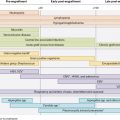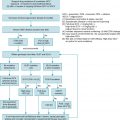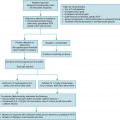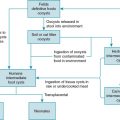Antimicrobial stewardship refers to the appropriate selection, dosing, route, and duration of antimicrobial therapy to optimize patient outcomes and minimize toxicity and the development of resistant pathogens. Over the past decade, the number of pediatric antimicrobial stewardship programs (ASPs) has increased. Pediatric ASPs, which typically include dedicated pediatric infectious diseases–trained physicians and pharmacists, have expanded from freestanding children’s hospitals to pediatric units within larger hospitals to less traditional settings, such as community hospitals, emergency departments, and outpatient clinics.
Although the prevalence and scope of pediatric ASPs is increasing, the optimal role of ASPs in the management of pediatric immunocompromised patient populations is less defined. Immunocompromised patients represent a small proportion of all pediatric hospitalizations but account for a large proportion of antimicrobial use. We review the goals of antimicrobial stewardship in the transplant population, barriers to its implementation, and offer specific stewardship strategies that may be useful in this population.
Goals of stewardship in immunocompromised hosts
The basic goals of antimicrobial stewardship in immunocompromised hosts are the same as in other children: to maximize therapeutic success by optimizing choice, dose, route, and duration of therapy while limiting unintended consequences such as adverse events and cost. Stewardship can, however, be challenging in immunocompromised hosts, particularly in the transplant population. Because of multiple previous rounds of antimicrobial therapy, which may include prophylaxis, transplant recipients are more likely to be colonized with multidrug-resistant organisms, complicating empiric antibiotic choices. And even when the conditions of these patients improve with empiric therapy, their often profound immune deficiency and comorbid conditions, some of which mimic infection, may make de-escalation difficult as well.
It is crucial that stewardship teams develop expertise in immunocompromised hosts. This requires knowledge not only of the wide array of infectious diseases affecting these patients but also the mechanisms and impact of various immunosuppressive regimens to understand the specific arm(s) of the immune system rendered vulnerable and the opportunistic infectious diseases that exploit these deficiencies. Furthermore, stewardship teams should partner with immunocompromised patient care teams, including oncology, solid organ transplant, and bone marrow transplant services, to develop a working knowledge of protocols and approach to the antimicrobial prescribing by these services. Ideally, stewardship teams should collaborate with immunocompromised patient teams to optimize antimicrobial use in these populations, not dictate unilaterally.
Conducting stewardship requires a complete assessment of the risks and benefits of antimicrobial prescribing. On the one hand, these patients are at high risk of invasive infection and should be treated aggressively. On the other hand, use of broad-spectrum agents will further drive resistance, already present at a higher rate in this population, and may contribute to development of graft-versus-host-disease and Clostridium difficile infection (CDI). To further complicate the issue, clinicians may have different thresholds of risk. For example, the primary team may focus on the potential value of aggressive antimicrobial therapy (i.e., broader therapy for a longer duration), whereas the stewardship team may focus more on acute (e.g., organ toxicity, drug-drug interactions) and chronic (e.g., antimicrobial resistance, microbiome disruption) adverse events.
The role of antibacterial prophylaxis is a prime example of the challenges in this population. In adult hematopoietic stem cell (HSCT) recipients, the use of fluoroquinolone prophylaxis is common. The evidence is less clear in children. A recently published randomized placebo-controlled trial of levofloxacin prophylaxis administered during the first 2 cycles of chemotherapy found a significant decrease in the incidence of bacteremia for children with acute myeloid acute and relapsed lymphoblastic leukemia. A smaller, nonsignificant decrease in the incidence of bacteremia was seen in the subgroup of children after HSCT. Therefore implementing prophylaxis in this population depends on how the risks of antibacterial exposure are considered compared with a potential, albeit not statistically significant, decrease in bacteremia.
Although most pediatric stewardship efforts have focused on antibacterial agents, immunocompromised hosts are at high risk for complications from fungal and viral infections. Therefore strategies for antifungal and antiviral stewardship need to be considered in this population. The significant variability in use of these medications across institutions for both prophylaxis and treatment further highlights this need. A review of 2015 data from the Pediatric Health Information System database examined antifungal and antiviral use at 47 freestanding children’s hospitals. Although high-risk patients accounted for less than 5% of all hospital discharges, they accounted for nearly half of the antiviral and antifungal use. Specifically, HSCT recipients accounted for 20% of all antifungal use and 24% of all antiviral use. Although this cohort was limited to high-risk patients, there was still significant variation in prescribing, demonstrating the need for stewardship of these agents. Antivirals and antifungals are ideal targets for stewardship interventions because they are often inappropriately prescribed, have narrow therapeutic windows, and are costly. Although the most important strategies for antifungal and antiviral stewardship remain to be elucidated, therapeutic drug monitoring and development of protocols for fungal prophylaxis are examples.
Diagnostic stewardship is another important consideration. In otherwise healthy children, the use of rapid diagnostics has decreased time to optimal therapy, leading to better patient outcomes. Several studies have documented that having a stewardship pharmacist to act on results of these tests is more effective than the mere availability of the results. In addition to helping interpret these test results, stewardship teams can have an active role in determining criteria for laboratory test ordering. Unnecessary testing can lead to increased costs as well as to treatment of organisms that are normal colonizers and not true pathogens.
Other stewardship goals include the reduction of redundant antimicrobial coverage, promotion of the oral route of antibiotics over the intravenous route, and prevention of CDI.
Barriers to antimicrobial stewardship programs in immunocompromised children
Understanding barriers and challenges to effective antimicrobial stewardship, especially those that differ between targets and populations, is important to planning, implementing, modifying, and evaluating a stewardship program. Barriers to antimicrobial stewardship in immunocompromised pediatric patients may be similar to those in other populations, but there are some unique aspects. Issues particularly challenging to stewardship efforts in the immunocompromised population include the lack of evidence or consensus for optimal prevention and treatment of infection, diagnostic uncertainty, medical complexity and risk of severe or life-threatening infections, and the relatively high risk of antimicrobial-resistant infections.
Paucity of evidence for prevention and management of infections
Although evidence for management of some infectious syndromes in immunocompromised children exists, , it is the exception rather than the rule. For example, despite intensive research, optimal management of febrile neutropenia in children with cancer remains controversial. The aim of empiric management is to provide immediate, appropriate therapy to prevent progression to sepsis and its associated morbidity and mortality. One issue is stratification of risk for neutropenic children when fever is the presenting symptom, which drives initial antimicrobial therapy decisions. Significant work has attempted to design a system that uses clinical signs, symptoms, and laboratory tests to identify which patients with febrile neutropenia have an underlying serious infection requiring broad-spectrum antibiotic therapy. However, in contrast to effective protocols in adults, many pediatric approaches have performed poorly in validation attempts, and those that have been validated are poorly specific or require collection of relatively large amounts of local data to recalibrate before implementation at each institution. Furthermore, although it seems reasonable that a formal decision support system might be safe and improve antimicrobial use, this has not yet been shown. This lack of evidence can lead to widespread use of unnecessarily broad empiric antimicrobial therapy. Other areas where evidence is lacking include duration of therapy for infections or fever in immunocompromised children, appropriate antibiotic treatment of infectious intraabdominal syndromes such as colitis/typhlitis, , and the long-term safety or efficacy of antibacterial prophylaxis. , ,
Diagnostic uncertainty
There are also difficulties associated with diagnostic tools for infection in immunocompromised hosts. This is problematic because stewardship interventions often rely on identification of a clear clinical syndrome (e.g., by diagnostic imaging) or demonstration of a microbiologic etiology for infection. Most episodes of fever in this population, however, have no etiology identified, and serious infection can exist even without localizing signs or symptoms. One example is lung infection, for which microbiologic diagnostics have low yield for bacterial and fungal etiologies across pediatric populations. However, because the differential diagnosis is broader in immunocompromised patients and the required treatment duration may be longer, the potential impact of diagnostic uncertainty is amplified in this population. Efforts to improve this by early use of bronchoalveolar lavage or biopsy , have met resistance from clinicians concerned about diagnostic yield, risk-benefit ratio, and cost-effectiveness. , The phenomenon of poor diagnostic tools in the context of a broad differential diagnosis also applies to a number of other infections, including skin and soft tissue infections, intraabdominal infections, presumed disseminated invasive fungal infections, and persistent fever without source, all of which can be associated with prolonged courses of broad-spectrum antimicrobials without a clear need. This issue is further confounded by the problem of discriminating graft-versus-host-disease and organ rejection from infection in transplant patients.
Contributing to this problem of diagnostic uncertainty is the relative dearth of accurate diagnostic tests for the pediatric immunocompromised population. For example, biomarkers, such as C-reactive protein and procalcitonin, which have been successful in discrimination of patients with bacterial infection from those with viral infection or no infection in some populations, appear to be unreliable in immunocompromised children, possibly because of their altered immune response to infection. Similarly, diagnostic tests that are sensitive and specific for invasive fungal infection in immunocompromised adults, such as (1,3)-β-D-glucan and specific findings on computed tomography scans, perform poorly in children, leading to a high rate of “presumed” fungal infection. ,
Concerns for polymicrobial or multiple infections
Improved diagnostics may not completely solve the problems associated with diagnostic uncertainty. Early data suggesting that use of narrow-spectrum antibiotics for treatment of susceptible infections in profoundly immunocompromised hosts was associated with a high risk of breakthrough infection have contributed to a culture of maintaining broad-spectrum coverage, even when a causative organism is recognized. , Similarly, improved diagnosis of viral pneumonia in immunocompromised hosts may not lead to reduced antibiotic use because of concerns about undiagnosed polymicrobial infection.
Provider autonomy and the stewardship team
A number of barriers to stewardship have been attributed in the literature to differing approaches between the stewardship team and the primary clinicians caring for immunocompromised patients—for example, transplant physicians, surgeons, and oncologists. , , , It is important to note that many of these factors are subjective and are reported as perceived barriers by stewardship clinicians. The most frequently reported barrier is that, perhaps because of the frequency of serious infections in this population, primary clinicians may be more concerned about rare adverse infection outcomes than about long-term risks or financial costs related to antibiotic use. This may lead to excessive or inappropriate antimicrobial use. Concern about loss of autonomy by allowing external input into routine patient management may also be an issue. ASP clinicians report that their efforts to improve antimicrobial use are hindered by insufficient input into local or protocol-related treatment guidelines. Lastly, it is important to note that despite some positive effects of antimicrobial stewardship interventions in immunocompromised populations, inappropriate prescribing typically persists, albeit at a somewhat lower level.
End-of-life care
Although the overall chance of long-term survival is high for many immunocompromised pediatric patients, some will enter into palliative care. During the period of palliative care, inappropriate antimicrobial prescribing is common. This can occur because antibiotics are considered harmless or benign, so continuing these can be a way of maintaining treatment even when no therapy is available for the primary disease. This is supported by multiple studies showing that antibiotics are frequently administered at the end of life, often without undertaking appropriate tests and without an infectious disease diagnosis. ,
Antimicrobial stewardship programs
Most pediatric antimicrobial stewardship clinicians report that improving antimicrobial use in immunocompromised children is a priority for their program and that they believe that they have sufficient experience in infections in this population. However, because of the issues described earlier, interventions in this population can be extremely time intensive, which can be challenging in environments where only limited stewardship resources are available. Importantly, it seems that not all stewardship providers are equivalent in the immunocompromised setting. In one study, an effective stewardship program became markedly less effective after trainee specialists were substituted for the attending physicians who had originally performed the interventions. , This suggests that academic or institutional authority may be an important component to stewardship in this population; insufficient power or authority has been previously identified as an issue by ASP clinicians in an international survey. Lastly, it is important to note that building trust with primary clinicians relies on accurate recommendations, and there is evidence that infectious diseases clinicians may underestimate the risk of serious infection related to specific patient presentations, which could lead to inappropriate ASP interventions and erode trust.
Strategies and tactics for stewardship in immunocompromised hosts
Despite these barriers, many centers have developed stewardship initiatives in their immunocompromised populations. Seo and colleagues surveyed 127 adult and pediatric HSCT centers, 107 of which also performed SOT, about their stewardship practices. Responses were received from 71 (56%) centers, of which 62 had active ASPs. Of the centers surveyed, 12 were freestanding children’s hospitals, but pediatric-specific results were not reported separately. Survey responses were reported separately for HSCT and SOT, but there were no significant differences in use of specific strategies between these two patient populations.
Formulary restriction and guideline development were the most common interventions and were used by more than 70% of the responding centers. Prospective audit with feedback, education, and dose optimization and prior authorization were also common. Most stewardship strategies were adapted from Infectious Diseases Society of America recommendations for development of stewardship programs in general. Few data exist to determine optimal stewardship strategies in transplant patients, with even fewer data in the pediatric transplant population.
Horikoshi and colleagues report the impact of ASP activities on the hematology/oncology and HSCT units of a metropolitan hospital in Tokyo, Japan. The ASP started with postprescription review of carbapenems, then expanded to include prior authorization for carbapenems and other activities, such as prospective audit with feedback, therapeutic drug monitoring, selective reporting, guidelines for febrile neutropenia, weekly educational series, and implementation of molecular diagnosis for viral infections. Results were not reported separately for oncology and HSCT patients, but the HSCT unit accounted for 36,150 of 49,642 (73%) total patient-days during the study period. Although it is not possible to determine which specific component had the most impact, stewardship bundles led to significant decreases in days of therapy. Notably, there was no difference in infection-related or all-cause mortality associated with this decrease in antibiotic use.
Clinical guideline development is another key stewardship strategy that has been shown to be successful in pediatric transplant patients. Wattier and colleagues reported a decrease in use of second gram-negative antibiotic therapy after creation of a dedicated HSCT fever and neutropenia guideline at a tertiary care children’s hospital. Before guideline development, ciprofloxacin and tobramycin were frequently used as double gram-negative coverage. Using time-series analysis, the authors describe a 99% level change decrease for tobramycin and a 95% decrease for ciprofloxacin. Importantly, there was no increase in mortality associated with these reductions in second gram-negative coverage. The protocol for general oncology patients was separate from that for HSCT recipients, highlighting the importance of specific unit and provider group-based guidelines.
Other guidelines commonly used in the transplant population include those for antifungal prophylaxis, treatment for invasive fungal infection, and cytomegalovirus prophylaxis and treatment. De-escalation is another strategy that may benefit from development of a specific guideline. Although challenging in this population, de-escalation may be more likely to be achieved if there is an agreed-upon protocol in place with objective indicators to identify in which patients de-escalation may be safe. Regardless of the specific topic, it is critical to identify key partners on the respective transplant teams to realize the value of stewardship and ensure that the goals of the stewardship and primary teams remained aligned.
Some centers develop individualized treatment plans for patients who are known to be colonized with multidrug-resistant organisms, leading to more appropriate empiric prescribing. Furthermore, by encouraging discussions between the stewardship, infectious diseases and transplant teams before a child becomes ill, this activity in and of itself can help establish a culture of collaboration.
Other strategies less commonly used in the transplant population include the use of automatic stop dates, use of order forms, and antibiotic cycling. Allergy delabeling is another promising stewardship strategy that may be effective in transplant recipients. In the adult oncology population, the presence of β-lactam allergies had been shown to be associated with worse clinical outcomes and increased cost. Although not specifically studied in this population, these findings likely extend to immunocompromised pediatric patients who often require long-term broad-spectrum therapy. It would be beneficial to determine which children have true antibiotic allergies using a combination of patient questionnaires and penicillin skin testing before transplantation to optimize correct antimicrobial use.
Stewardship metrics in the transplant population
In their survey of transplant centers, Seo and colleagues reported that the rate of CDI was the most common outcome measured by ASPs in the transplant setting, followed by antimicrobial cost. Antimicrobial use was only measured by 34% of HSCT centers and 27% of SOT centers; 23% of centers reported that they did not follow any stewardship outcomes in transplant patients.
Rates of antimicrobial resistance were less commonly measured but should be considered as an important metric. Because of the frequent use and escalating breadth of antimicrobial therapy in the transplant population, patients are likely to become colonized with more resistant pathogens. Some hospitals produce transplant-unit specific antibiograms to capture this information. However, because transplant patients often spend time in and out of the intensive care unit, emergency department, and outpatient clinics, it can be difficult to attribute their pathogens to a specific patient unit. At least one center uses SOT patient-specific compared to unit-specific antibiograms to overcome this issue.
Although some metrics, such as rates of CDI, methicillin-resistant Staphylococcus aureus, vancomycin-resistant enterococci, and antimicrobial cost, are required to be reported, it is important to measure outcomes that are of importance to the transplant teams. This will further serve to build confidence and trust in the stewardship program.
Conclusion and future research
Pediatric HSCT and SOT recipients are important targets for antimicrobial stewardship efforts. There are limited published data to determine the optimal stewardship interventions in this population, but the general strategies outlined in the Infectious Diseases Society of America stewardship guidelines are a reasonable place to start.
Several topics appear well-suited for further study. For example, ongoing pediatric studies of duration of therapy for common infections, such as pneumonia, urinary tract infection, and uncomplicated bacteremia, need to be extended into the immunocompromised host. Additionally, when appropriate, adult transplant initiatives should be extended into the pediatric age group. For example, a recent study of early de-escalation of broad-spectrum antibiotics in adult HSCT recipients with febrile neutropenia and negative culture results found that this strategy did not lead to worse clinical outcomes and successfully decreased days of therapy and the incidence of CDI. Given the relatively small number of pediatric transplants at the national level, multicenter collaborative efforts are needed to answer these important questions.
References
Stay updated, free articles. Join our Telegram channel

Full access? Get Clinical Tree








